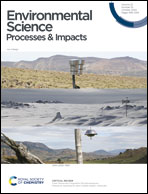Highly sensitive multi-residue analysis of veterinary drugs including coccidiostats and anthelmintics in pond water using UHPLC-MS/MS: application to freshwater ponds in Flanders, Belgium†
Abstract
Veterinary drugs, such as coccidiostats and anthelmintics are routinely administered in extensive animal husbandry, finding their way into the aquatic environment through urine and/or feces of treated animals kept outdoors or by the application of contaminated liquid manure on agricultural fields and subsequent mechanisms of surface run-off, leaching and drift. Several of these compounds are known to exert acute and chronic toxicity effects on aquatic organisms, and can lead to changes in biodiversity and ecosystem functioning. The overall objective of this research was to develop, validate and apply a highly sensitive, multi-residue SPE-UHPLC-MS/MS method for the determination of 12 coccidiostats, registered as a feed supplement or veterinary medicine in Europe and three regularly used anthelmintics, in pond water, often functioning as amphibian habitat. Sample extraction was optimized using a fractional factorial resolution design. Pond water filtration efficiency (i.e. 80–118%, ≤25% RSD) and matrix effects (i.e. 72–119%, ≤39% RSD) were evaluated using water from respectively 3 and 20 different ponds in Flanders. By incorporating internal standards, overall results improved and adequate precision values (i.e. ≤15%) were obtained according to the EMA guidelines. Acceptable within-run and between-run apparent recoveries, satisfactory precision as well as good linearity were demonstrated according to the CD 2002/657/EC, SANTE/12682/2019 and VICH 49 guidelines, except for robenidine for which the between-day precision was between 21.0 and 34.5%. Sample storage stability studies indicated that storage at 4 °C and analysis performed within 96 hours after sampling was sufficient to avoid loss by degradation for all compounds, excluding robenidine. Values for the limit of detection (LOD) and quantification (LOQ) were in nanograms per liter, which was essential for the environmental application of this novel method. The method was successfully applied on grab water samples from the water surface of 18 different ponds across Flanders, Belgium, detecting amprolium and levamisole at concentrations below the LOQ of 2.5 ng L−1 and at 250.0 ng L−1 or below the LOQ of 250.0 ng L−1, respectively. In conclusion, our newly developed method may provide insights about the contamination status of amphibian breeding ponds.



 Please wait while we load your content...
Please wait while we load your content...